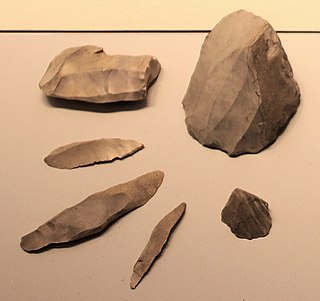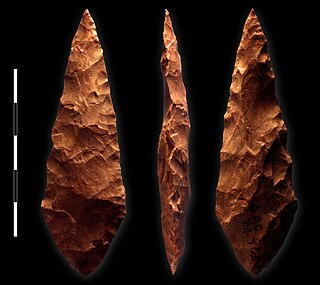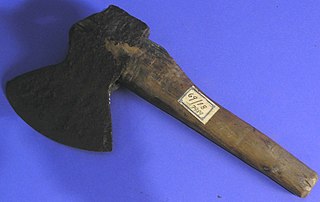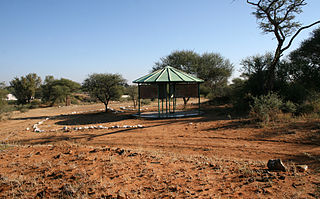Related Research Articles

A microlith is a small stone tool usually made of flint or chert and typically a centimetre or so in length and half a centimetre wide. They were made by humans from around 35,000 to 3,000 years ago, across Europe, Africa, Asia and Australia. The microliths were used in spear points and arrowheads.
A spear is a pole weapon consisting of a shaft, usually of wood, with a pointed head. The head may be simply the sharpened end of the shaft itself, as is the case with fire hardened spears, or it may be made of a more durable material fastened to the shaft, such as bone, flint, obsidian, copper, bronze, iron, or steel. The most common design for hunting and/or warfare, since ancient times has incorporated a metal spearhead shaped like a triangle, diamond, or leaf. The heads of fishing spears usually feature multiple sharp points, with or without barbs.

Acheulean, from the French acheuléen after the type site of Saint-Acheul, is an archaeological industry of stone tool manufacture characterized by the distinctive oval and pear-shaped "hand axes" associated with Homo erectus and derived species such as Homo heidelbergensis.
Kathu is a town in South Africa, and the iron ore capital of the Northern Cape province. Its name means "town under the trees", after the Camel Thorn forest it is situated in. The phrase "the town under the trees" was coined by an engineer working in the town in the early-1990s as part of a tourist marketing drive, together with the accompanying graphic. It was intended to be a marketing slogan. The meaning of the word "Kathu" has anecdotically been attributed to a porridge brewed by the local population from the powder found in the pods of the Camel Thorn trees.

Africa has the longest record of human habitation in the world. The first hominins emerged 6-7 million years ago, and among the earliest anatomically modern human skulls found so far were discovered at Omo Kibish, Jebel Irhoud, and Florisbad.

An arrowhead or point is the usually sharpened and hardened tip of an arrow, which contributes a majority of the projectile mass and is responsible for impacting and penetrating a target, as well as to fulfill some special purposes such as signaling.

Fauresmith is located 130 km south west of Bloemfontein, South Africa. The town, named after Rev Phillip Faure and Sir Harry Smith, is the second oldest town in the Free State.

The Middle Stone Age was a period of African prehistory between the Early Stone Age and the Late Stone Age. It is generally considered to have begun around 280,000 years ago and ended around 50–25,000 years ago. The beginnings of particular MSA stone tools have their origins as far back as 550–500,000 years ago and as such some researchers consider this to be the beginnings of the MSA. The MSA is often mistakenly understood to be synonymous with the Middle Paleolithic of Europe, especially due to their roughly contemporaneous time span; however, the Middle Paleolithic of Europe represents an entirely different hominin population, Homo neanderthalensis, than the MSA of Africa, which did not have Neanderthal populations. Additionally, current archaeological research in Africa has yielded much evidence to suggest that modern human behavior and cognition was beginning to develop much earlier in Africa during the MSA than it was in Europe during the Middle Paleolithic. The MSA is associated with both anatomically modern humans as well as archaic Homo sapiens, sometimes referred to as Homo helmei. Early physical evidence comes from the Gademotta Formation in Ethiopia, the Kapthurin Formation in Kenya and Kathu Pan in South Africa.

Eartham Pit is an internationally important archaeological site north-east of Boxgrove in West Sussex with findings that date to the Lower Palaeolithic. The oldest human remains in Britain have been discovered on the site, fossils of Homo heidelbergensis dating to 500,000 years ago. Boxgrove is also one of the oldest sites in Europe with direct evidence of hunting and butchering by early humans. Only part of the site is protected through designation, one area being a 9.8-hectare (24-acre) geological Site of Special Scientific Interest, as well as a Geological Conservation Review site.

Hafting is a process by which an artifact, often made of bone, stone, or metal is attached to a haft. This makes the artifact more useful by allowing it to be launched by a bow (arrow), thrown by hand (spear), or used with more effective leverage (axe). When constructed properly, hafting can tremendously improve a weapon's damage and range. It is estimated that hafted weapons were most common during the Upper Paleolithic and Middle Paleolithic. It was one of the first tools where hominins took separate elements and united them into a single tool. The development of hafting is considered by archaeologists to have been a significant milestone. It was not only an improvement in the technology at the time; it also showed the progression of the human mind toward a world of complex tool-making.
Wonderwerk Cave is an archaeological site, formed originally as an ancient solution cavity in dolomite rocks of the Kuruman Hills, situated between Danielskuil and Kuruman in the Northern Cape Province, South Africa. It is a National Heritage Site, managed as a satellite of the McGregor Museum in Kimberley. Geologically, hillside erosion exposed the northern end of the cavity, which extends horizontally for about 140 m (460 ft) into the base of a hill. Accumulated deposits inside the cave, up to 7 m (23 ft) in-depth, reflect natural sedimentation processes such as water and wind deposition as well as the activities of animals, birds, and human ancestors over some 2 million years. The site has been studied and excavated by archaeologists since the 1940s and research here generates important insights into human history in the subcontinent of Southern Africa. Evidence within Wonderwerk cave has been called the oldest controlled fire. Wonderwerk means "miracle" in the Afrikaans language.

Sibudu Cave is a rock shelter in a sandstone cliff in northern KwaZulu-Natal, South Africa. It is an important Middle Stone Age site occupied, with some gaps, from 77000 years ago to 38000 years ago.
Howiesons Poort is a technological and cultural period characterized by material evidence with shared design features found in South Africa, Lesotho, and Namibia. It was named after the Howieson's Poort Shelter archaeological site near Grahamstown in South Africa, where the first assemblage of these tools was discovered. Howiesons Poort is believed, based on chronological comparisons between many sites, to have started around 64.8 thousand years ago and ended around 59.5 thousand years ago. It is considered to be a technocomplex, or a cultural period in archaeology classified by distinct and specific technological materials. Howiesons Poort is notable for its relatively complex tools, technological innovations, and cultural objects evidencing symbolic expression. One site in particular, Sibudu Cave, provides one of the key reference sequences for Howiesons Poort. Howiesons Poort assemblages are primarily found at sites south of the Limpopo River.

Canteen Kopje is an archaeological site, formally protected as a grade 2 provincial heritage site, and approved in 2017 for re-grading to national status, situated outside Barkly West in the Northern Cape, South Africa. The place was previously known as Klipdrift, meaning stony drift, a translation from a still earlier !Ora name, !a |aub. Canteen Kopje is best known for its long and exceptionally rich Earlier Stone Age sequence, spanning circa >0.5 to 1.7 million years, occurring within gravels exposed in late nineteenth/early twentieth century mining pits. Also attracting attention are more recent archaeological levels in the overlying Hutton Sands, which contain material known as Fauresmith, Middle Stone Age, Later Stone Age, and late Iron Age with evidence of protocolonial/colonial contact and interaction, probably, with nineteenth century diamond diggers.
The Buttermilk Creek complex is the remains of a paleolithic settlement along the shores of Buttermilk Creek in present-day Salado, Texas. The assemblage dates to ~13.2 to 15.5 thousand years old. If confirmed, the site represents evidence of human settlement in the Americas that pre-dates the Clovis culture.
In archaeology, Fauresmith industry is a stone tool industry that is transitional between the Acheulian and the Middle Stone Age. It is at the end of the Acheulian or beginning of the Middle Stone Age. It is named after the town of Fauresmith in South Africa. The Fauresmith is found at a number of other archaeological sites such as Wonderwerk Cave and Kathu Pan where it is potentially dated to at least 420,000 years ago. The Fauresmith consists of Middle Stone Age technology such as blades, points and prepared core technology as well as retaining handaxes from the Acheulian. The type sites are Brakfontein 321 and Riverview Estates Site VI. The Fauresmith culture shows Levalloisean influence, with hand-axes and flakes with faceted striking platforms. It is largely in the similar period with the Sangoan industry.

Toca da Tira Peia is a rock shelter site, located in the municipality Coronel José Dias, Piauí state, near the Serra da Capivara National Park, Brazil, thought to hold evidence of prehistoric human presence in South America dating to 22,000 years ago.

Peter Bernhard Beaumont was a South African archaeologist noted for his excavation and finds at Wonderwerk Cave, Kathu, Canteen Kopje and Border Cave, all in South Africa. His work led to the conviction that, rather than trailing Europe and Asia, Southern Africa's Stone Age technology and culture had set the pace.
Rose Cottage Cave (RCC) is an archaeological site in the Free State, South Africa, situated only a few kilometers away from Ladybrand, close to the Caledon River, on the northern slopes of the Platberg. RCC is an important site because of its long cultural sequence, its roots in modern human behavior, and the movement of early modern humans out of Africa. Rose Cottage is the only site from the Middle Stone Age that can tell us about the behavioral variability of hunter-gatherers during the Late Pleistocene and Holocene. Berry D. Malan excavated the site between 1943 and 1946, shortly followed by Peter B. Beaumont in the early 1960s, and the most recent excavations occurred from 1987 to 1997 by Lyn Wadley and Philip Harper in 1989 under Wadley's supervision. Humans have inhabited Rose Cottage for over 100,000 years throughout the Middle and Later Stone Ages. Site formation and sediment formation processes at Rose Cottage appear to be primarily anthropogenic. Archaeological research focuses primarily on blade technology and tool forms from the Middle Stone Age and the implications of modern human behavior. Structurally, the cave measures more than 6 meters deep and about 20 by 10 meters. A boulder encloses the front, protecting the cave, but allowing a small opening for a skylight and narrow entrances on both the east and west sides.
Lawrence H. Keeley was an American archaeologist best known for pioneering the field of microwear analysis of lithics. He is also known for his 1996 book, War Before Civilization: The Myth of the Peaceful Savage. Keeley worked as a professor of archaeology at the University of Illinois Chicago.
References
- ↑ Beaumont, P.B., 2004. Kathu Pan and Kathu Townlands/Uitkoms. In: Morris, D. & Beaumont, P.B. (Eds.), Archaeology in the Northern Cape: Some Key Sites. Southern African Association for Archaeologists Postconference Excursion, Kimberley, McGregor Museum: pp. 50–53
- ↑ Chazan, M., Wilkins, J., Morris, D. & Berna, F. 2012. Bestwood 1: a newly discovered Earlier Stone Age living surface near Kathu, Northern Cape Province, South Africa. Antiquity 86(331): Antiquity Gallery.;
- ↑ Porat, Naomi; Chazan, Michael; Grün, Rainer; Aubert, Maxime; Eisenmann, Vera; Horwitz, Liora Kolska (2010). "New radiometric ages for the Fauresmith industry from Kathu Pan, southern Africa: Implications for the Earlier to Middle Stone Age transition". Journal of Archaeological Science. 37 (2): 269–283. doi:10.1016/j.jas.2009.09.038. hdl: 1885/18556 . ISSN 0305-4403.
- 1 2 Wilkins, Jayne; Chazan, Michael (2012). "Blade production ~500 thousand years ago at Kathu Pan 1, South Africa: support for a multiple origins hypothesis for early Middle Pleistocene blade technologies". Journal of Archaeological Science. 39 (6): 1883–1900. doi:10.1016/j.jas.2012.01.031. ISSN 0305-4403.
- ↑ Wilkins, J.; Schoville, B. J.; Brown, K. S.; Chazan, M. (2012). "Evidence for Early Hafted Hunting Technology". Science. 338 (6109): 942–946. doi:10.1126/science.1227608. ISSN 0036-8075.
- ↑ First stone-tipped spear thrown earlier than thought